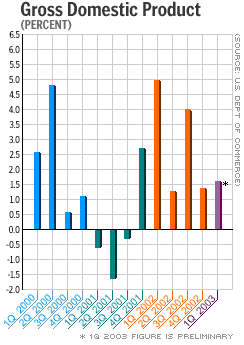NEW YORK (CNN/Money) - The pace of U.S. economic growth improved slightly in the first quarter of 2003, the government said Friday, but not nearly as much as economists expected.
Gross domestic product (GDP), the broadest measure of the world's largest economy, grew at a 1.6 percent annual rate in the quarter after growing 1.4 percent in the fourth quarter of 2002, the Commerce Department reported. Economists, on average, expected GDP growth of 2.3 percent, according to a Reuters poll.
"Although the current growth environment is not impressive, positive growth is still positive growth," said Anthony Chan, chief economist at Banc One Investment Advisors. "On the darker side of things, however, we must admit that the economy still lacks the growth momentum needed to correct many of the labor market ailments."

U.S. stock market futures had little reaction to the report, pointing to a mixed opening on Wall Street. Treasury bond prices were mostly higher.
The weak GDP report was due mostly to an anemic 1.4-percent growth rate in consumer spending, which makes up more than two-thirds of total GDP. It was the slowest rate since the second quarter of 2001, in the midst of that year's recession.
Business spending on plants and equipment shrank at a 4.2-percent pace, after expanding at a 2.3-percent rate in the fourth quarter. Business spending on equipment on software shrank at a 4.4 percent rate, ending a three-quarter rally.
GDP shrank for three straight quarters in 2001, as the economy fell into its first recession since 1990-91. The economy has grown since the fourth quarter of 2001, but the recovery has been exceptionally choppy, and by some measures has been the weakest recovery since World War II.
Because private payrolls still are 2.6 million jobs thinner than they were at the beginning of the recession, and because businesses have shown not the slightest sign of hiring again, the current recovery is often compared to the "jobless recovery" that followed the 1990-91 downturn.
But this period of joblessness has been worse -- the year-to-year change in private payrolls has been negative for 21 straight months, according to the Labor Department, the longest stretch since 1944-46.
| Related stories
|

|
|
|
|
Part of the reason for the disappointing recovery could be the nature of the recession. Unlike most other U.S. recessions, which usually are triggered by a slowdown in consumer spending, businesses caused the latest downturn, snapping their wallets shut after the spending and investment spree of the late 1990s.
Most other recessions end when a surge of pent-up consumer demand is turned into spending, leading businesses to increase their production and hiring. In this recession/recovery cycle, however, consumers never stopped spending.
The economy is instead waiting on a surge in business spending, which improved somewhat in late 2002 but relapsed at the beginning of 2003.
"Although the U.S. economy has managed modest real growth through 2002 and into 2003, most economists agree that a strong and well-balanced recovery will require a greater contribution from the business sector, in the form of increased capital investment and hiring," Federal Reserve Governor Ben Bernanke said in a speech late Thursday.
Many economists, including Fed Chairman Alan Greenspan, think high productivity, low interest rates and low inventories have set the stage for a solid return of business investment later this year.
Other economists worry that businesses still have too much unused equipment sitting around, and they point to ongoing CEO pessimism about the economy and about demand as a sign that businesses have no reason to suddenly go on another spending and hiring spree.
If there's been a silver lining to the lingering weakness, it's that interest rates have fallen to 40-year lows and stayed there for several months, making borrowing easier and fueling a boom in home refinancing. Cash-out refinancings and lower mortgage payments have helped fuel consumer spending, and a hot housing market has made home-owners feel wealthier.
Residential spending continued apace in the first quarter, according to the Commerce Department report, growing at a 12 percent annual rate, the strongest performance since 14.2 percent growth in the first quarter of 2002.
But consumer spending on durable goods -- big-ticket items such as cars and appliances, meant to last three years or more -- fell for the second straight quarter, shrinking at a 1.1-percent rate. The decline was led mainly by another drop in automobile sales, which has led U.S. automakers to cut production targets and lay off workers.
Inflation continued to be a distant memory; the GDP's inflation measure, the personal consumption expenditures index, rose 2.8 percent in the quarter, but the bulk of that was due to higher energy costs. Oil prices rose on worries that a U.S.-led war with Iraq would hurt oil supply, and home heating bills rose due to severe winter weather.
Excluding food and energy costs, the PCE index rose just 0.9 percent in the first quarter, the weakest since a 0.7-percent rate in the third quarter of 2001, which included the Sept. 11 terrorist attacks.

|

